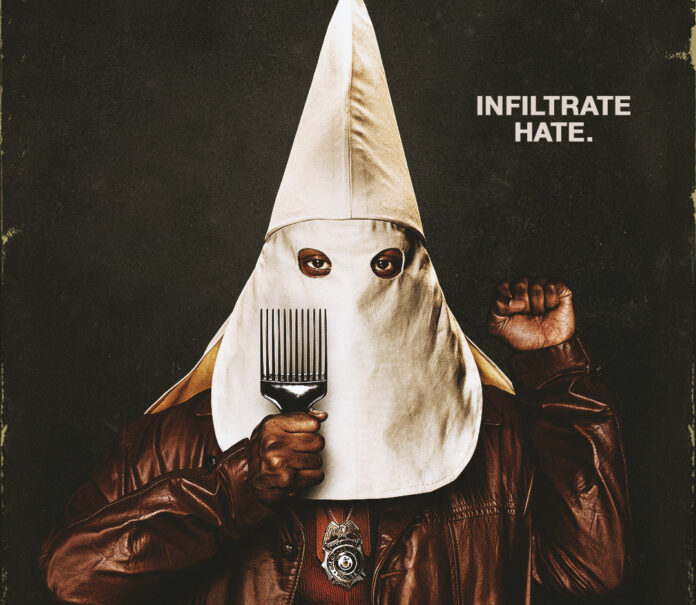Aimed squarely at multiplex audiences (yet still winning the Grand Prix at Cannes), Spike Lee’s powerful and entertaining BlacKkKlansman is quilted together from many pieces. The first piece involves the famous camera-crane, dolly-shot from Gone With the Wind where the screen ends up being filled with thousands of dead and dying Confederate soldiers. Then the clip stops, and the next piece features a white supremacist named Dr. Kennebrew Beauregard (Alec Baldwin) delivering an out-takes diatribe about miscegenation and mongrelization.
Flashing forward to 1979, a huge Afro tops the head of college graduate Ron Stallworth (John David Washington), while he is being interviewed for a detective position in the Colorado Springs Police Department. “You do understand you would be the first Negro on the force,” the Chief (Robert John Burke) informs him, and then assigns him to retrieve paper work in the records room. After several weeks, Stallworth asks the Chief to let him work undercover, and his first assignment is “wearing a wire” to a rally sponsored by the local university’s Black Student Union (BSU). The meeting features a speech by Kwame Ture (Corey Hawkins), the honorary prime minister of the Black Panther Party. Inspired by Ture’s words, Stallworth also finds himself attracted to BSU president, Patrice Dumas (Laura Harrier).
After the rally, the Chief assigns Stallworth to Intelligence. “What do they do there?” the rookie asks. Apparently part of collecting intelligence is to read every word in the local newspapers, including an ad recruiting white people to join the local KKK. Having been raised in El Paso, Texas, Stallworth’s “telephone voice” sounds white, and the local organizer, Walter Beachway (Ryan Eggold) quickly extends an invitation to come to a bar to “meet some of the guys.” It is only after he hangs up, that another cop points out Stallworth gave his own name in the phone call.
This “rookie mistake” dictates that another detective, Flip Zimmerman (Adam Driver) play the part of Ron Stallworth for any face-to-face meetings. Shuttled around to a “secret location” by the overly suspicious KKK member, Felix Kenderson (Jasper Paakonen), it place turns out to be Kenderson’s house where the wife plays hostess and serves snacks from a tray. Zimmerman also meets a few other members, including Ivanhoe (Paul Walter Hauser), a slow-witted fellow obsessed with guns (and things that go “boom”).
The whole thing is punctuated by Terrance Blanchard’s music which adds a Mod Squad vibe to the 1970‘s era scenes. In these pieces of the quilt, Lee presents the BSU members as articulate and dedicated, and the cops as supportive of the thin blue line (including even those who are blatantly racist). Except for Beachway, most of the KKK members appear to be ignorant, ill-educated, and paranoid. Contrast is provided by national Klan leader David Duke (Topher Grace)—who is certain a day will come when a xenophobic advocate of “white-is-right” sits in the White House.
Comprising several pieces of the quilt, the love-hate relationship between Stallworth and Dumas is explored in multiple ways. They stroll along a riverside bridge while debating the merits of various Blaxploitation films and which actress and actor—Pam Grier or Judy Pace; Melvin Van Peebles or Richard Roundtree; are the best. But he cringes when she uses the epithet “pigs,” and wants her to call them cops or policemen. “What difference does that make to you?” she asks. “Are you pig or something?” Through all the give-and-take, the pair act as equals—no Blaxploitation stereotypes for this man and woman.
Lee’s tendency to “soap-box” issues can seem preachy on occasion, but he knows most of the viewing audience isn’t old enough to remember the 1970’s, and needs this grab-you-by-the shirt perspective to make them aware that even though some things have changed, underneath too many things are still the same.
Comments? E-Mail gi*********@co*****.net
53.5
F
Healdsburg
December 21, 2024








